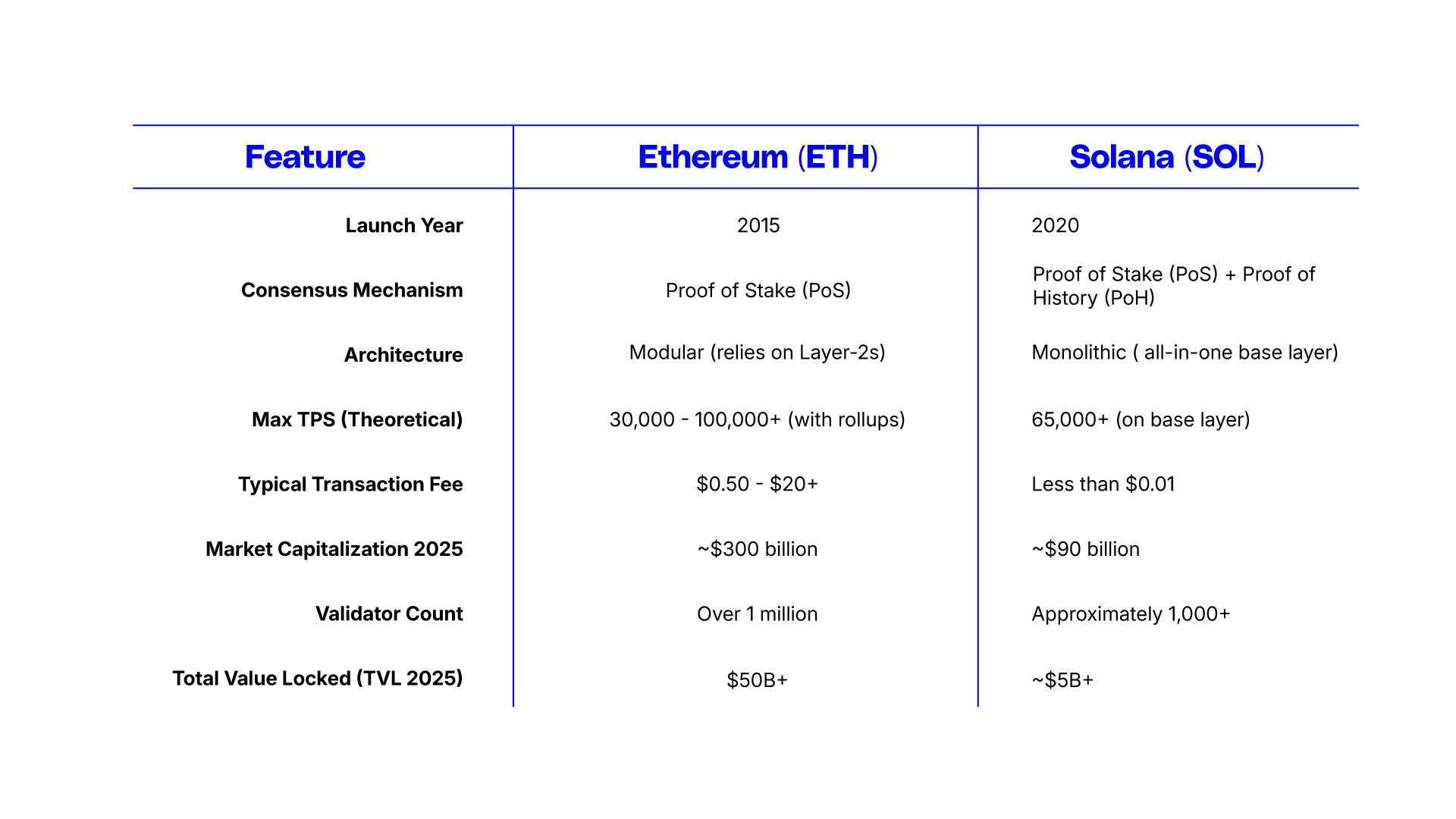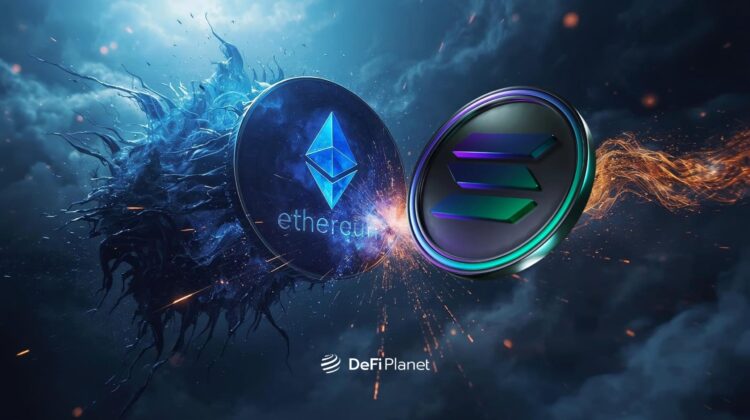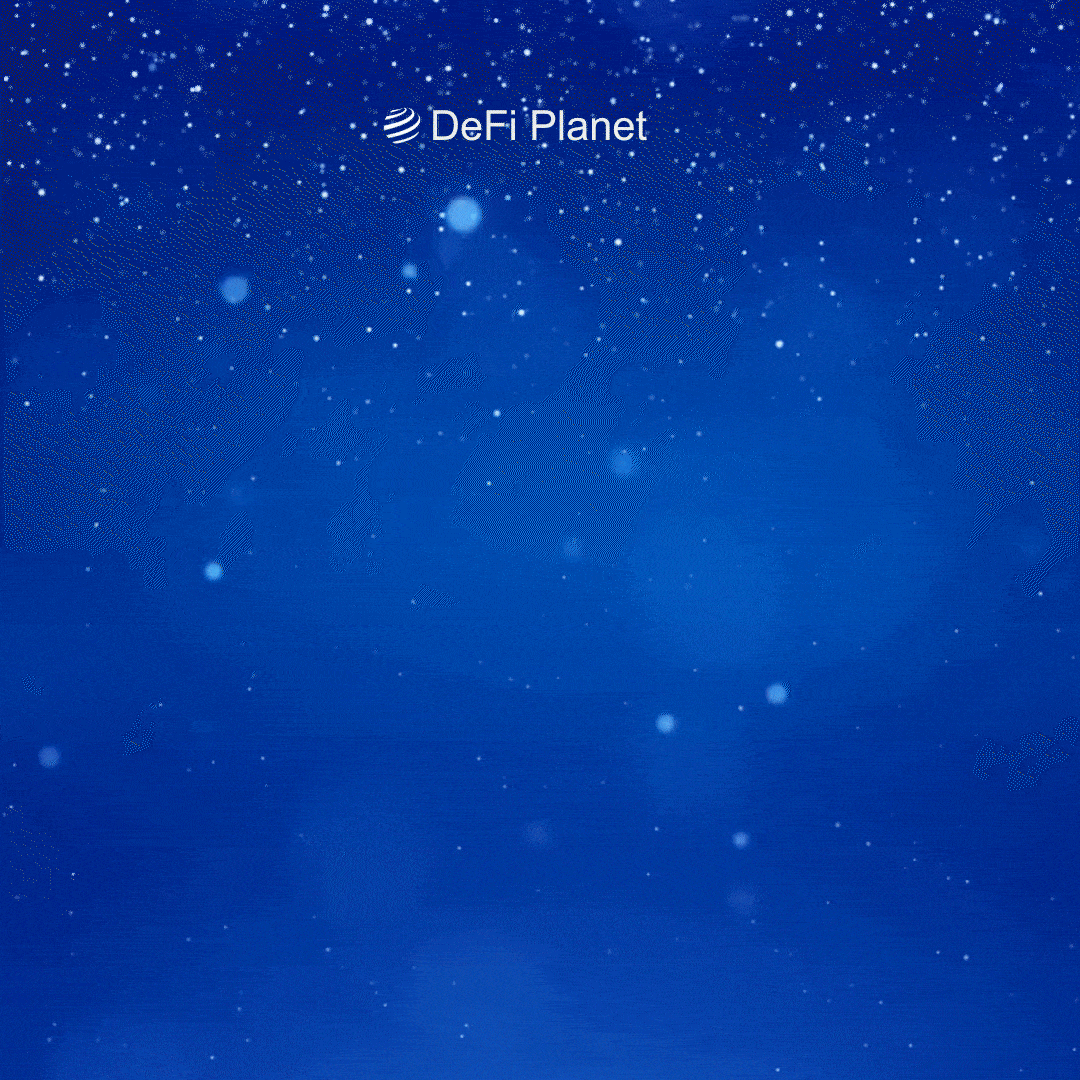Ethereum and Solana are two of the most important blockchains in the world right now and both allow developers to build smart contracts and decentralized apps (dApps), but they have different and unique strengths. Understanding these differences can help you answer questions like Could Solana surpass Ethereum? Should I build on Ethereum or Solana? And Will Solana explode in 2025? Let’s break it down.
Speed, Scalability, and Fees
Solana is built for speed, with its hybrid Proof-of-History (PoH) and Proof-of-Stake (PoS) design, Solana can handle tens of thousands of transactions per second (TPS), and some data suggests real-world speeds around 4,700 TPS, with transaction finality in less than one second. This makes Solana extremely fast and very cheap to use.
Ethereum, on the other hand, processes around 15–30 TPS on its main chain, even after switching to Proof-of-Stake in its Ethereum 2.0 upgrade. However, Ethereum builds its scalability using Layer-2 rollups, like Optimism and Arbitrum, and upcoming proposals like EIP-4844 (“proto-danksharding”) aim to reduce gas costs and improve performance across the network.
Developer Ecosystems and Tools
Ethereum is the oldest and most widely used smart contract platform. It’s like Web2’s “go-to” infrastructure. Developers use tools such as Solidity, Hardhat, Foundry, and Ethers.js; which are well-tested and supported across the ecosystem. Thousands of developers contribute through GitHub repositories; one study tracked over 129,000 commits to 10 key Ethereum projects over a decade. This depth leads to extensive documentation, tutorials, and community support.
Solana development relies on Rust and TypeScript, often using the Anchor framework. Rust can be more complex to learn, but Solana has grown quickly, gaining many new developers in 2024, about 7,625 new Solana devs versus 6,456 on Ethereum in Electric Capital’s survey. Tools like SuperTeam, Solana Stack, Blinks, Actions, and no-code platforms are making it much easier to build on Solana.
ethereum has no competitors
it’s the biggest, most decentralized settlement layer.
solana is just an execution layer
competing with both L1s and L2s.
to replace ethereum, you’d need solana AND multiple other L1s to scale
requiring trusted bridges for interoperability
which…
— rip.eth (@ripeth) March 10, 2025
Active Users and TVL
Ethereum leads in Total Value Locked (TVL) across DeFi. Platforms such as Uniswap, Aave, and MakerDAO still dominate, and Ethereum hosts most institutional-level DeFi activity.
Meanwhile, Solana is quickly carving out its space with its user appeal. Projects like Jupiter, Raydium, and Magic Eden have built vibrant DeFi and NFT ecosystems that cater especially to users who want fast and cheap transactions. By 2025, Solana’s daily transaction volumes and active address counts have even surpassed Ethereum’s core metric.
Core Stats at a glance
Ethereum and Solana offer two very different visions for scaling decentralized applications globally. Below is a side-by-side look at how they compare across key technical and economic metrics:

Both Ethereum and Solana are built to support the future of Web3, but they do so with different philosophies. Ethereum focuses on flexibility and decentralization through modular upgrades and external layers. Solana, on the other hand, bets on raw speed and unified architecture to deliver fast, low-cost performance directly from its base layer.
Security and Reliability
Ethereum is known for being one of the safest blockchain platforms for building apps. It’s been around since 2015, so people have had years to test it, fix bugs, and improve it. Most big apps built on Ethereum; like Uniswap, Aave, and MakerDAO, hold billions of dollars. That’s why their code is vetted very carefully by experts, a process called an audit. Developers also use tools like eThor, which help find problems in smart contracts before anything goes wrong. With over 1 million validators and strong coding standards, Ethereum is trusted by people all over the world.
Solana, on the other hand, is much faster, but it has had more technical problems. The network has gone offline several times in the past, sometimes for hours, because of bugs or too many users trying to send transactions at once. This makes people worry that it may not be reliable enough for important apps. Some Solana smart contracts have had security issues because some developers don’t have all the right tools or experience yet.
The coming days have seen Solana getting better, with a tool called Anchor helping developers write safer and clearer code. The Solana community is also investing money to teach developers how to build more secure apps. More experts are doing audits for Solana projects, and updates are being made to stop spam attacks and improve the network’s performance. These changes are making Solana more stable and secure every day.
In summary, Ethereum is still ahead when it comes to security and reliability, but Solana is catching up fast and as both networks grow and improve, making them safer for users and developers will remain very important.
Price, Institutional Support, and Outlook
Solana has seen strong growth recently, trading around $166 in June 2025, and many investors are optimistic about its future. Some analysts predict that it could rise to $180–$230 later this year, and in more bullish scenarios, possibly even reach $300, especially if trading volumes stay high and new projects continue launching on the network. The growing interest in DeFi, NFTs, and AI applications built on Solana has helped attract both developers and retail users, contributing to this price momentum.
Meanwhile, Ethereum has been more stable, holding around $2,800, but experts expect it to climb higher by the end of 2025. Some forecasts place Ethereum’s price between $4,500 and $5,000, thanks to growing adoption of staking, improved Layer-2 scalability, and the recent approval of Ethereum ETFs. These exchange-traded funds are a big deal, they let traditional investors buy into Ethereum without needing to use crypto wallets, which boosts demand and market confidence.
Regulation is also working in Ethereum’s favor. The U.S. Securities and Exchange Commission (SEC) officially approved Ethereum ETFs, a major step toward bringing crypto into the mainstream financial system. Some analysts believe that Solana could be next in line for ETF approval, which would further legitimize the network in the eyes of institutional investors. However, others remain cautious, noting that Solana still faces regulatory uncertainties and technical risks that might delay such progress (fnlondon.com).
Overall, both blockchains are gaining attention for different reasons; Solana for its performance and ecosystem growth, and Ethereum for its established network, regulatory clarity, and deeper integration with traditional finance. As we move through 2025, market trends, regulatory updates, and developer activity will continue to shape their paths, and possibly determine which chain becomes the top choice for builders and investors alike.
.jpg)
Can Solana Surpass Ethereum?
It’s unlikely that Solana will completely surpass Ethereum’s ecosystem dominance in the short term. Ethereum’s long-established infrastructure, developer network, and institutional backing give it a secure lead. However, Solana is rapidly gaining ground in certain areas. It offers better speed, lower costs, and a strong appeal for retail DeFi users and NFT collectors.
Rather than replacing Ethereum, Solana is likely to complement it. Ethereum will continue to serve institutions, developers, and complex DeFi use cases, while Solana may dominate in fast-paced applications like gaming, NFTs, and micro-transactions.
Best Use Cases
If you’re wondering “Should I build on Ethereum or Solana?”, the answer depends on your needs:
- Choose Ethereum if security, mature tooling, Layer-2 integration, and institutional-grade DeFi matter most.
- Choose Solana if your project demands ultra-fast transactions, very low fees, or easy access for mobile users.
Every blockchain has its own unique trade-offs in the grand scheme of all things blockchain. Ethereum offers robust decentralization and security, while Solana provides unmatched speed and cost-efficiency.
Final Take
Year 2025 is proving to be an exciting time for both blockchains. Solana is exploding in growth, especially among retail builders and users. Its speed and ecosystem are capturing attention and capital. Meanwhile, Ethereum remains firmly at the center of the Web3 world, offering unmatched developer support, financial infrastructure, and long-term stability.
They won’t replace each other completely, each has its niche and the “developer war” isn’t about one chain winning outright, but about two ecosystems evolving side by side to serve different needs. As you think about “Will Solana explode in 2025?” or “Can Solana replace Ethereum?”, it’s more accurate to ask: Which chain suits your project best?
Disclaimer: This article is intended solely for informational purposes and should not be considered trading or investment advice. Nothing herein should be construed as financial, legal, or tax advice. Trading or investing in cryptocurrencies carries a considerable risk of financial loss. Always conduct due diligence.
If you want to read more market analyses like this one, visit DeFi Planet and follow us on Twitter, LinkedIn, Facebook, Instagram, and CoinMarketCap Community.
Take control of your crypto portfolio with MARKETS PRO, DeFi Planet’s suite of analytics tools.”





















